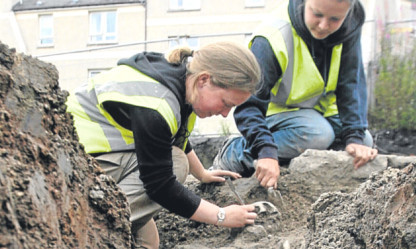A flooring company is seeking £1 million in compensation after the discovery of an ancient burial ground prevented it from building on its newly purchased land.
Direct Flooring bought the site on Riggs Road, Perth, in 2006, but a legal company acting for the sellers, First Scottish Property Services Ltd (FSPSL), failed to tell it about a requirement for archaeological excavations to be carried out.
Investigations uncovered 103 skeletons and a 15th century friary and spiralling costs led Direct Flooring to abandon the project.
The company behind the flooring firm, Manorgate, is now looking for £1,211,818.69 plus interest from FSPSL.
Solicitors acting for Direct Flooring had asked the sellers for a property enquiry certificate, which was designed to highlight any problems with the site. FSPSL was given the job of providing the certificate.
After the site was given a clean bill of health, Direct Flooring director John Semple agreed to pay £385,000 for the site.
The firm later discovered the archaeological conditions attached to the site but decided to push ahead with development as it was already committed financially and believed it could still turn a profit.
After costs reached £250,000, however, it decided the site was no longer commercially viable and abandoned the project.
FSPSL defended the claim, saying it did not believe that Mr Semple would have been put off buying the site had he known about the requirement to carry out archaeological investigations.
It also claimed Direct Flooring was negligent in relying solely on the certificate and called for damages to be capped at the level of the loss of value in the land.
Lord Stephen Woolman rejected FSPSL’s defences and said a decision was needed on how great Direct Flooring’s losses were.
In a written judgment, he said: “In my opinion, the crucial fact is that FSPSL held itself out as providing a specialist searching service. It expected recipients to rely on its certificates.
“Matters went awry because it supplied Manorgate with inaccurate information. That, in my view, was the dominant cause of the loss.
“The archaeological designation of the site should have been noted in an appropriate property search. In this case, First Scottish Property Services Limited carried out the search. It provided a property enquiry certificate, which the sellers’ solicitors exhibited to Manorgate. The PEC failed to disclose the archaeological designation.
“Manorgate now claims damages of £1,211,818.69, together with interest. Put broadly, that sum is based upon the lost capital value of the site, site investigation costs, trading losses and development losses.
“FSPSL admits that it was negligent. It accepts that the PEC should have referred to the archaeological designation but it maintains a number of lines of defence.
“In my view, these lines of defence fall to be rejected and the real question is the proper calculation of Manorgate’s loss.”
Lord Woolman decided to set another date for a hearing relating to the exact costs.
The friary was established in the 15th century by the Order of the Brothers of Our Lady of Mount Carmel, or Carmelites, who were also known as the White Friars due to the colour of their habits.
Over the centuries, the friary fell into disuse and its buildings became derelic although its existence was marked by the naming of Whitefriars Road.
